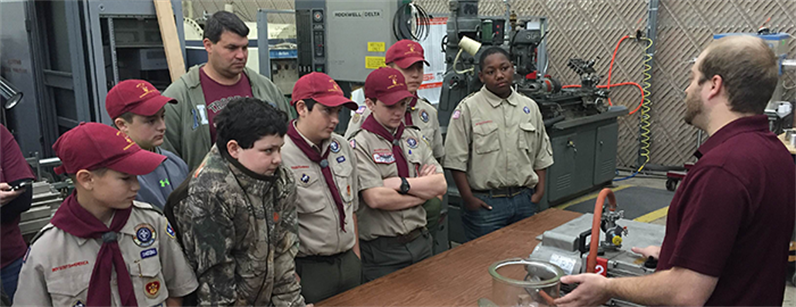
The Texas A&M University chapter of the American Nuclear Society (ANS) recently hosted a nuclear science merit badge workshop for local area troops of the Boy Scouts of America (BSA). Faculty from the Department of Nuclear Engineering, in conjunction with ANS volunteers, helped the scouts work through various requirements to earn the nuclear science merit badge and provided hands-on educational experiences at both the Nuclear Science Center (NSC) and at labs within the University Services Building. The instructors also provided classroom instruction on a range of nuclear theory related topics.
Senior nuclear engineering student and ANS public relations coordinator Andrew Foster helped coordinate the event and also served as a certified merit badge counselor for the scouts. Foster said that this outreach program with the BSA has gone back as far as 2010 and has done much to interest young boys in careers in the fields of nuclear science and engineering.
“We like to see late middle-school aged if not high-school aged boys with some sort of science class under their belt,” Foster said. “We have a template to run this workshop and take it through its different facets — nuclear power technologies and radiation safety protection — many topics to where it kind of becomes a crash course in nuclear and mirrors in some ways what undergraduate students would take in a nuclear 101 class.”
The ANS volunteers and faculty members who participated helped the scouts with the various requirements needed to complete the merit badge, which revolve around a curriculum in the areas of nuclear power, radiation safety, nuclear science theory and an introduction to the career opportunities available in the fields of nuclear science and engineering. Foster said the workshop, which allowed the scouts to tour Dr. Lin Shao’s accelerator laboratory and visit the nuclear reactor in the NSC, works to go beyond the minimum requirements of the merit badge to help the scouts develop an interest in science and other science, technology, mathematics and engineering (STEM) related activities.
“If we can get them to come in and see what we do and see the projects we are working on, they can see that this is kind of cool,” Foster said. “By the end of the day they were all super excited about wanting to become Aggie engineers and that is what we are striving for with this program — to give them the knowledge and cultivate that interest.”
Foster, who wants to help expand the program to include a workshop for the Girl Scouts of America, said that in addition to informing young children and stimulating their interest in the fields of nuclear science and engineering, these types of outreach programs help to alleviate public confusion about nuclear power applications.
“It makes me happy and proud because I feel nuclear is sometimes incorrectly viewed by the public, and to see that these kids want to get involved with this is a real highlight for us,” Foster said. “We try to get the negative stigma of nuclear out of the equation and we try and show them how radiation helps them in their day to day lives and how it is about more than just nuclear bombs and radiation.”